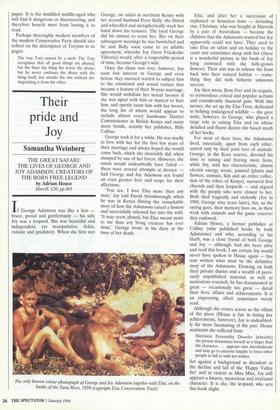Their pride and Joy
Samantha Weinberg
THE GREAT SAFARI: THE LIVES OF GEORGE AND JOY ADAMSON, CREATORS OF THE BORN FREE LEGEND by Adrian House
Harvill, £20, pp.465
If George Adamson was like a lion brave, proud and gentlemanly — his wife Joy was a leopard. She was beautiful and independent, yet manipulative, fickle, volatile and predatory. When she first met
George, on safari in northern Kenya with her second husband Peter Bally, she flirted and wheedled and metaphorically stuck her hand down his trousers. The loyal George did his utmost to resist her. But on their subsequent meetings he was bewitched and he and Bally soon came to an affable agreement, whereby Joy (born Friederike Viktoria) would, after a respectable period of time, become George's wife.
Once the chase was over, however, Joy soon lost interest in George and even before they married started to subject him to the emotional and sexual torture that became a feature of their 36-year marriage. She would withdraw her sexual favours if she was upset with him or wanted to hurt him, and openly taunt him with her lovers, the long list of whom would appear to include almost every handsome District Commissioner in British Kenya and many more beside, notably her publisher, Billy Collins.
George took it for a while. He was madly in love with her for the first few years of their marriage and always hoped she would come back, which she invariably did, when dumped by one of her lovers. However, the union would undoubtedly have failed there were several attempts at divorce had George and Joy Adamson not found an even greater love and scope for their affections.
`You see, I love Elsa more than any man,' Joy told David Attenborough, when he was in Kenya filming the remarkable story of how the Adamsons raised a lioness and successfully released her into the wild. 'It may seem absurd, but Elsa meant more to me than any living creature has ever done,' George wrote in his diary at the time of her death.
The only known colour photograph of George and Joy Adamson together with Elsa, on the banks of the Tana River, 1959 (copyright Elsa Conservation Trust). Elsa, and after her a succession of orphaned or homeless lions — including one, Christian, who was bought at Harrods by a pair of Australians — became the children that the Adamsons wanted but Joy apparently could not have. They used to take Elsa on safari and on holiday to the coast and sometimes sleep with her (there is a wonderful picture in the book of Joy lying entwined with the fully-grown lioness). Their aim was to release the lions back into their natural habitat — some- thing they did with hitherto unknown success.
Joy then wrote Born Free and its sequels, to tremendous critical and popular acclaim and considerable financial gain. With this money, she set up the Elsa Trust, dedicated to helping endangered wildlife — she gave none, however, to George, who played a large role in raising Elsa and on whose detailed and fluent diaries she based much of her books.
For most of their lives, the Adamsons lived, essentially, apart from each other, united only by their joint love of animals. George, in the Kora reserve, devoted his time to raising and freeing more lions, while Joy, with her characteristic, almost electric energy, wrote, painted (plants and flowers, animals, fish and an entire collec- tion of the tribes of Kenya), nurtured first cheetah and then leopards — and argued with the people who were closest to her. Both died tragically and violently (Joy in 1980, George nine years later), but, as the saying goes, their memory lives on, in their work with animals and the game reserves they endowed.
Adrian House, a former publisher at Collins (who published books by both Adamsons) and who, according to his blurb, was a close friend of both George and Joy — although, had she been alive and read this book, I am certain Joy would never have spoken to House again — has now written what must be the definitive story of the Adamsons. Drawing on both their private diaries and a wealth of previ- ously unpublished material, as well as meticulous research, he has documented in great — occasionally too great — detail their lives, affairs and achievements. It is an engrossing, albeit sometimes wordy read.
Although she comes across as the villain of the piece (House is fair in listing her achievements, however), Joy is undoubted- ly the more fascinating of the pair. House maintains she suffered from
Histrionic Personality Disorder [whereby] the person dramatises herself as a larger than life character . . . appears vain, inconsiderate and may go to extreme lengths to force other people to fall in with her wishes.
Set against a background as decadent as the decline and fall of the 'Happy Valley Set' and as violent as Mau Mau, Joy still appears a bizarre, mysterious and irrational character. It is she, the leopard, who sets this book alight.










































 Previous page
Previous page